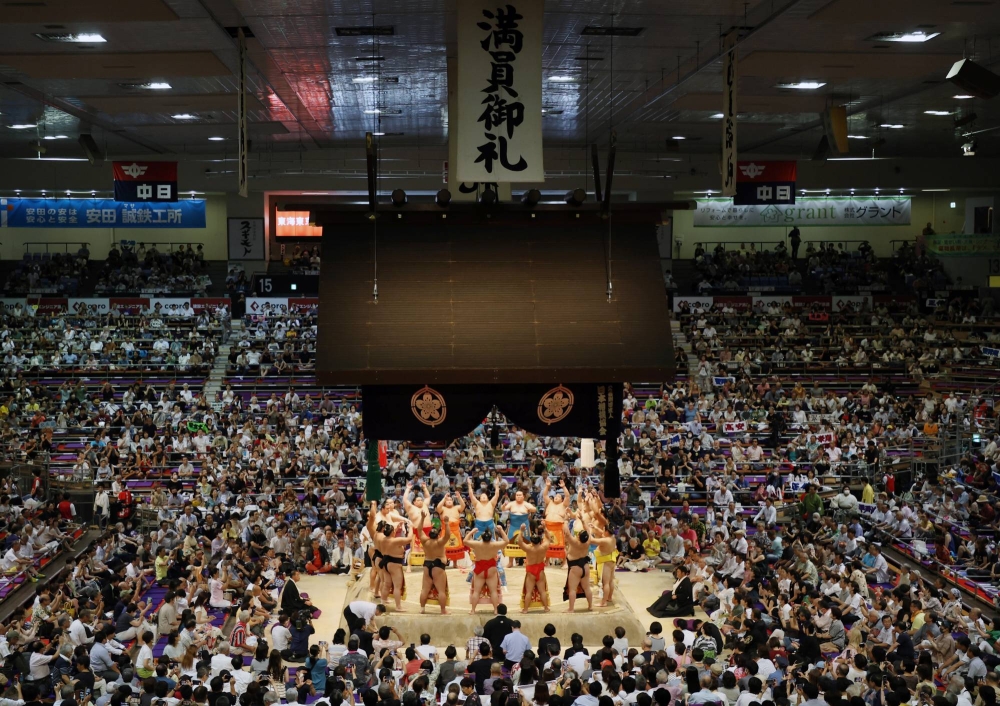With temperature records already being broken around Japan this month, it’s fitting that the sumo world is preparing to say farewell to a venue that is notorious for its intense heat and humidity.
The upcoming Nagoya Grand Sumo Tournament will be the last to be held at Dolphins Arena — also known as Aichi Prefectural Gymnasium — before the meet moves next year to IG Arena, which is currently under construction.
In addition to having a much larger capacity, the new venue should offer far more comfortable conditions than the arena it is replacing as host of central Japan’s biggest sumo event.
The air conditioning at Dolphins Arena has long struggled to provide cooling to seats nearer the ring, and spectators furiously flapping hand fans became a yearly sight at the July meet.
To be fair, that outdated system was at least an upgrade over the blocks of ice and fans used in its predecessor — Kanayama Gymnasium — a converted aircraft hangar that hosted sumo tournaments in Nagoya between 1958 and 1964.
Conditions in Kanayama were so intolerable that oxygen tanks were available for use by fans and the meet was given the nickname “The Tropical Tournament.” That moniker was never more appropriate than in 1960 when a thunderstorm smashed a window in the building’s roof and torrential rain soaked those in ringside seats during a top-division bout between Tamanoumi and Wakamaeda.
As summer temperatures in Japan continue to reach dangerous levels earlier and more often — in large part because of human-caused climate change — the need for better air-conditioned venues becomes more acute, making the IG Arena’s debut a timely one.
But while the new setting will almost certainly provide a more enjoyable experience for fans, the hope is that action on the raised ring will retain the heat that the July meet and the Aichi Prefectural Gymnasium have long been famous for.
Whether expressed in post-bout celebrations, or the intensity of wrestlers’ thrusts and slaps, the Nagoya tournament has often seemed to have more bite than other honbasho.
At times, that spilled over into unpleasantness, with a famous example being yokozuna Asashoryu brawling with compatriot Kyokushuzan in the dressing room in 2003 — and then breaking the side mirror on the latter man’s car in the parking lot — following a heated exchange in the ring.
Mostly, though, the fire was channeled into positive directions and resulted in some of the most exciting bouts and tournaments of recent years.
From Terunofuji’s miracle-like return after years in the wilderness to claim a second title in 2020 (albeit in a tournament held in Tokyo due to the pandemic), to Hoshoryu’s ozeki promotion-clinching roller coaster ride last year, the fourth basho of the year has often thrown up white-knuckle action and wild finishes.
It’s no coincidence that yokozuna Hakuho’s fist pump and roar after defeating Terunofuji to complete a swansong 15-0 title run in 2021 came in Nagoya.
Those worried that a plush new home may take away the hardships which have fostered such intensity need not worry.
Sumo’s new home in central Japan may be state of the art, but outdoor practice rings and spartan accommodations remain the standard for sumo stables when in the Nagoya region.
Having to train every morning in brutal conditions means that frazzled rikishi funneling their frustration and discomfort into intensity in tournament bouts is something unlikely to change for the foreseeable future, no matter how nice the IG Arena turns out to be.
Some aspects of the new Nagoya venue are bound to be different, however.
It will be interesting to see to what extent modern climate control in the arena reduces the issue of a slippery dohyō surface that at times has made the July meet look more like skating than sumo.
A more pleasant fan experience could also impact the atmosphere inside the arena.
It’s a well-known phenomenon that upgraded stadiums often lose the fervency that made them special, with better food, seats, sight lines and overall comfort serving to tame rowdy fans,making arenas less intimidating places for opposing teams to visit.
In England, the term used is “prawn sandwich brigade” after a famous rant in 2000 by then-Manchester United captain Roy Keane in which he railed against luxury suites and fans more interested in the gameday experience than what was happening on the field.
Sumo, of course, doesn’t have the same kind of home and away situation, but regional tournaments in Osaka and Nagoya have long been famous for exuberant fans, who are more willing to express their opinions — and at greater volumes.
Nagoya, in particular, has seen some wild incidents and had a (now-defunct) tradition of fans rushing the dohyō at the end of a tournament, tearing it apart with hands and shovels in order to bring home dirt or straw bales as souvenirs.
Regardless of what changes the new arena brings in 2025, there is another modern “tradition” that could foreseeably come to an end just as Dolphins Arena’s time as host draws to a close, namely Mongolia’s monopoly of the Emperor’s Cup in Nagoya.
The past five July tournaments have been won by five different Mongolian-born wrestlers: Hoshoryu, Ichinojo, Hakuho, Terunofuji and Kakuryu.
Oshoma and Kirishima represent the best hopes of that streak continuing, but the rise of Onosato significantly lowers the likelihood of a sixth straight different wrestler from the same country emerging victorious in July.
Change is coming to Nagoya.
Most of it will be welcome, and some will spark feelings of nostalgia, but the 2024 tournament in Dolphins Arena will likely be the last one where both the action in the ring and fans in the stands are heated.

